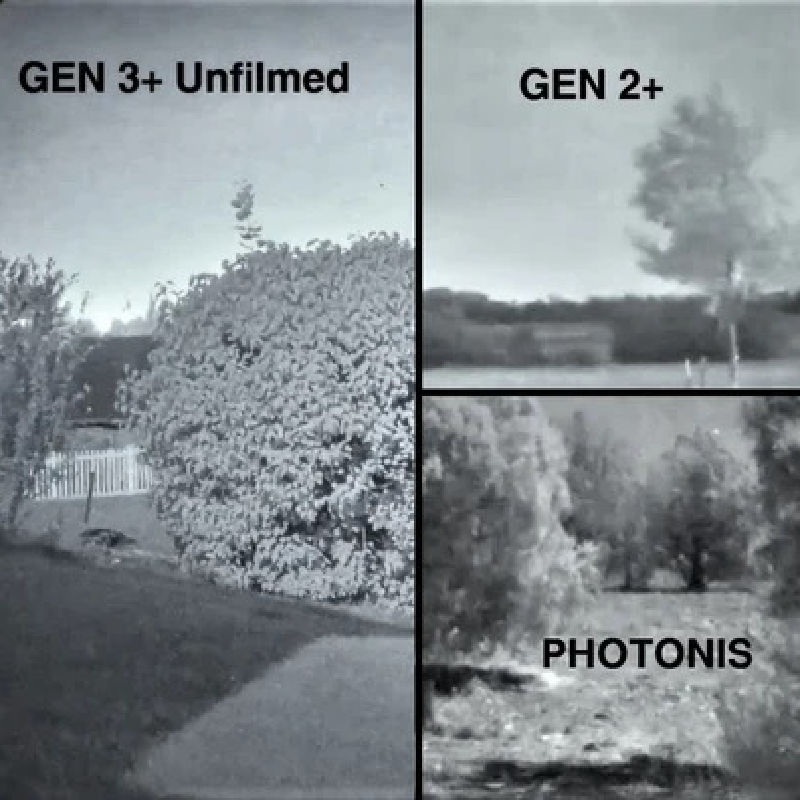
Night Vision Goggles: Understanding Tubes and Their Defects
Night vision goggles (NVGs) are an essential tool for military, law enforcement, hunters, and outdoor enthusiasts. They allow users to see in low-light or complete darkness by amplifying ambient light.
However, the heart of any NVG system is its image intensifier tube (IIT). Understanding the types of night vision tubes and their potential defects can help users make informed purchasing decisions.
What Are Night Vision Tubes?
Night vision tubes, also called image intensifier tubes (IITs), are the core component of NVGs. They work by collecting small amounts of light, amplifying it, and displaying a visible image to the user.
These tubes come in different generations and configurations, impacting performance, clarity, and durability.
Types of Night Vision Tubes
- Generation 1 (Gen 1) Tubes

Overview:
-
The earliest night vision technology, developed in the 1960s.
-
Amplifies ambient light several hundred times.
-
Affordable and widely available.
Pros:
-
Low cost and accessible for beginners.
-
Suitable for basic low-light applications.
Cons:
-
Lower resolution and clarity compared to newer generations.
-
Noticeable image distortion and lower light sensitivity.
-
Shorter lifespan (1,000-2,000 hours).
2. Generation 2 (Gen 2) Tubes

Overview:
-
Introduced in the 1980s with major improvements over Gen 1.
-
Uses a microchannel plate (MCP) to enhance image brightness and clarity.
-
Common in civilian and professional applications.
Pros:
-
Much better resolution and brightness than Gen 1.
-
Improved signal-to-noise ratio (SNR), leading to clearer images.
-
Longer lifespan (5,000 hours or more).
Cons:
-
More expensive than Gen 1.
-
Still not as advanced as Gen 3 in extreme low-light environments.
3. Generation 3 (Gen 3) Tubes

Overview:
-
The gold standard for military and tactical use.
-
Features gallium arsenide (GaAs) photocathodes, significantly improving light amplification.
-
U.S. military and law enforcement commonly use Gen 3 NVGs.
Pros:
-
Excellent image resolution and clarity.
-
High performance in extreme low-light conditions.
-
Long lifespan (10,000+ hours).
Cons:
-
High cost due to advanced technology.
-
Requires maintenance for optimal performance.
4. Generation 4 (Gen 4) Tubes

Overview:
-
Sometimes called "Gen 3+" due to refinements over Gen 3.
-
Improved auto-gated power supply and better contrast in varying light conditions.
-
Used by special forces and high-end users.
Pros:
-
Superior performance in all lighting conditions.
-
Minimal halo effect and faster adaptation to light changes.
-
Higher durability and efficiency.
Cons:
-
Extremely expensive and rare.
-
Only necessary for specialized operations.
Common Defects in Night Vision Tubes

Despite their advancements, night vision tubes can suffer from defects that impact performance. Understanding these defects can help users determine the quality of a tube before purchase.
1. Black Spots

Description: Small black dots or specks that do not change position. Cause: Tiny debris inside the tube or manufacturing defects. Impact: Minor black spots are normal, but excessive spots reduce image clarity.
2. Image Distortion

Types:
-
Edge Distortion: Warping or blurring around the outer edges of the field of view.
-
Barrel Distortion: Image appears curved or stretched.
-
Pincushion Distortion: Image looks pinched inward.
Cause: Lens misalignment or low-quality optics. Impact: Reduces usability, especially in high-precision applications.
3. Halo Effect

Description: A bright circular glow around light sources. Cause: Over-amplification of bright lights within the field of view. Impact: Can obscure details, making it difficult to operate in mixed lighting conditions.
4. Image Noise (Graininess)

Description: Grainy or static-like appearance, particularly in very dark areas. Cause: Low signal-to-noise ratio (SNR) in lower-end tubes. Impact: Reduces the overall image quality, especially in Gen 1 and some Gen 2 tubes.
5. Burn-in or Image Retention

Description: Faint ghost images remain on the screen. Cause: Prolonged exposure to bright lights. Impact: Permanent damage to the tube over time.
How to Choose the Right Night Vision Tube
Consider Your Application
-
Recreational Use: Gen 1 or budget Gen 2 options.
-
Hunting and Outdoor Activities: Gen 2+ or entry-level Gen 3.
-
Law Enforcement and Tactical Operations: Gen 3 or higher.
-
Military and Specialized Missions: Gen 4 or premium Gen 3.
Evaluate Tube Quality
-
Check for excessive black spots or image noise.
-
Look for high resolution and minimal distortion.
-
Choose auto-gated tubes for better adaptability in changing light conditions.
Final Thoughts
Selecting the right night vision tube is crucial for optimizing performance and ensuring longevity. Understanding the different generations, their strengths, and potential defects allows users to make informed decisions.
Whether for recreational use, hunting, or professional applications, investing in high-quality NVGs with the right image intensifier tube will enhance your night vision capabilities while minimizing defects.
By prioritizing quality and knowing what defects to watch for, you can ensure that your night vision goggles deliver the performance you need in any low-light environment.

